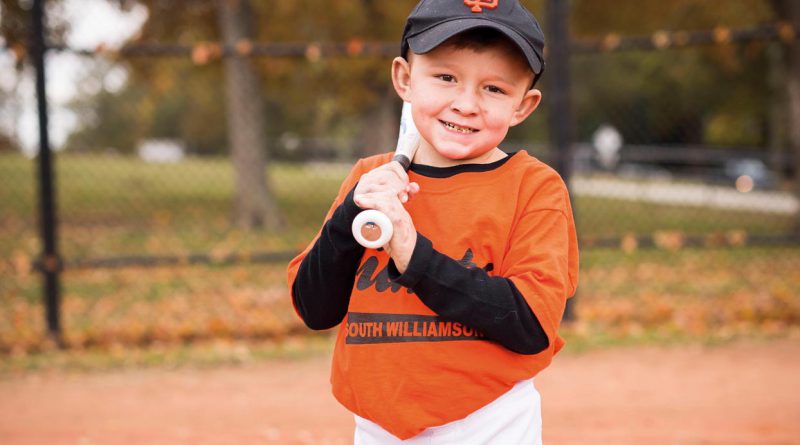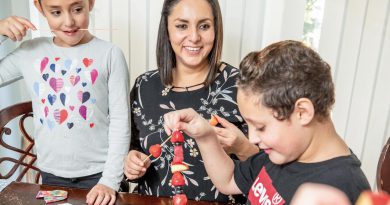Field of Dreams
Published on January 30th, 2019 by Christina Echegaray.
Amber Nickle watches in awe as her 5-year-old son runs the bases at his first tee-ball practice. She also sneaks peeks of him playing with groups of other children on the playground.
A year ago, Wyatt was barely walking. He was plagued by incessant itching. Shoes didn’t fit his feet due to growths caused by a liver condition.
But with the help of a multitude of medical specialists at Monroe Carell Jr. Children’s Hospital at Vanderbilt, Wyatt has made a remarkable health transformation that has allowed the Nickle family to experience basic milestones. Initially afraid for Wyatt’s future, they finally dared to dream.
“These are things we prayed about and dreamed about,” Nickle said. “It’s nice to be able to just breathe and be in cruise control. For the first four and a half years, we never experienced that.”
From the beginning
Before having children of her own, Nickle had been a nanny for 10 years. She was accustomed to the cries of a fussy baby.
For the first two months of her son’s life, she thought she was dealing with a colicky newborn.
But what she learned during Wyatt’s 2-month-old checkup was life changing. The date, July 8, 2013, is still seared in her mind.
“That is when everything changed. Everything shifted for us,” said Nickle, remembering the phone call that urged her to bring Wyatt to the Children’s Hospital Emergency Department. “Early that day during our visit, the pediatrician said Wyatt was looking a bit jaundiced (a yellow tint to the skin) and wanted to do some labs. We were told that if there was anything concerning, we would get a call from Vanderbilt. That call came around 5 p.m., and we were urged to get to the emergency room immediately.”
Nickle and her husband, John Louis, who was a nurse at Vanderbilt University Adult Hospital, were shocked by what they learned after a gamut of tests and a four-day hospitalization. Their son was diagnosed with Alagille syndrome, a rare genetic disorder that can affect the liver, heart and other parts of the body.
About 1 in 70,000 newborns is diagnosed with the disease, though it is not always detected in infancy. The condition manifests differently in every patient — some with an array of symptoms and effects, while other people never know they have the condition.
As Wyatt grew, the symptoms of the disorder began to severely impact him.
Developmental delays with muscle tone and learning became apparent. He required supplemental formula to ensure his nutritional needs were being met. And the telltale signs of the disorder became unbearable — itching and the development of xanthomas, or deposits of cholesterol in the skin.
“We felt so out of control,” said Nickle. “Our only job as parents was to provide and protect, and we couldn’t do either of those things for him. The wait-and-see period was tough. We didn’t want his condition to define him or us. We didn’t want it to be a crutch or to control him.
“Within the walls of our home, we felt stuck. We didn’t let others know that.”
Tough decisions
Wyatt’s unrelenting cries and begging for the itching (caused by the condition) to cease became a regular occurrence in the Nickle household.
“He was waking up every two to three hours,” said Nickle. “He would scratch himself and cry out in the middle of the night. We would hear him over the baby monitor crying, ‘Mommy, help. Mommy, help.’
“And there was nothing we found to keep him from scratching his skin raw. We tried to keep him in footy pajamas, but he would scratch and rub his feet together and create holes and scratch through those. His feet, ears, nose and face were the worst. They were hot spots.”
Drug trials and myriad medications to manage the symptoms were not successful. The pair had exhausted all available treatments, and they wanted to pursue curative options.
In 2017, the decision was made to seek liver transplantation for Wyatt. The choice was not an easy one. To be placed on the liver transplant waitlist, Wyatt would require open-heart surgery to repair narrowing of both pulmonary arteries, which compromised blood flow to the lungs, as well as to repair narrowing in the aorta that limited blood flow to the rest of the body. The repairs were particularly important in order to take the additional burden off the donor liver.
David Bichell, MD, William S. Stoney, Jr. Professor of Cardiac and Thoracic Surgery at Children’s Hospital, performed the surgery.
“This case was an interplay of all of our specialists,” said Bichell. “We wanted to do the fewest invasive procedures as possible with the largest impact. We had to have a plan that included doing what was best for the liver. To ensure an optimal situation for the transplanted liver to do well, we needed to fix the heart first.
“When you talk about our Children’s Hospital, you point to fully integrated teams. We pride ourselves in having strengths in all our pediatric specialties. We work really hard to ensure that everyone is thinking about the entire patient and not just their area of expertise.”
Wyatt’s heart surgery was in January 2017. Nine months later, he was placed on the liver transplant list.
In the meantime, not only was Wyatt tormented by intolerable itching, but the xanthomas were developing under his skin. Although not painful, the sensitive, fatty growths covered his body and limited his mobility as well as his ability to accomplish tasks using fine motor skills.
The xanthomas were the result of extremely high cholesterol due to the liver damage caused by Alagille syndrome. According to his medical team, his cholesterol levels “were among the highest” recorded at Children’s Hospital. These growths can appear anywhere on the body, including the eyelids and face, but are most often are found in the joints (knees and elbows), feet and hands. They can vary in size from as small as a pinhead to as large as a grape.
The clustered growths caused rising alarm for Wyatt’s parents and physicians.
“Being a normal little boy sounds so simple,” said Nickle. “Kids were calling him ‘monster’ because he looked different. Even though you know your child’s value, it hurt to think, ‘Will he be 6 or 8 years old and still hearing this?’
“He didn’t really know what he was hearing, and he didn’t understand it, but that would last only so long.”
According to Sophoclis Alexopoulos, MD, chief of Vanderbilt’s Division of Hepatobiliary Surgery and Liver Transplantation, many children with Alagille become progressively disfigured with xanthomas.
“I think that the quality of a person’s life is just as important as the quantity of someone’s life,” said Alexopoulos. “One of the drivers in moving forward with transplantation was the xanthomas, and then add on the fragile bones and the incessant itching.
“This was a really tough decision for his parents because it is not a scenario where the child is going to die without a transplant. It is a case where you are desperate to improve the quality of your child’s life. When you are making that kind of risk-benefit decision, it’s very difficult.”
Alagille is a rare disease, reiterated Alexopoulos. Patients with this disease do not typically receive transplants at Vanderbilt — until Wyatt.
“We are growing our pediatric liver program. We have a multidisciplinary approach with very good outcomes. We are proud of all the expertise the entire team brings, and because of that skill level, we are able to treat so many more children with liver disease.”
In 2018, the pediatric liver transplant team performed seven transplantations. Alexopoulos hopes to grow the program to 15 transplants in 2019.
Road to transplantation
Wyatt was placed on the liver transplant list in October 2017. The Nickles were told it could take a few months before the right organ was located for their son.
In early October, Wyatt was placed in a body cast after he fractured his leg while playing. Two weeks later, Nickle received the call from the hospital that a potential liver was available.
She panicked.
“I remember calling my husband and asking to be put on a three-way call,” she said. “My husband asked if we could have 20 minutes to talk. He had just pulled into our neighborhood. He came into the house, looked at me and said, ‘We can’t fix Wyatt ourselves, but they can. They feel very good about this. This is what Wyatt needs.’”
Shortly after midnight on Oct. 26, Wyatt was rolled into his room in the pediatric intensive care unit, where his parents waited during the nearly eight-hour surgery. When it was over, they immediately recognized an improvement in their son’s skin color.
It was four days later that Nickle recognized the biggest change.
“With past procedures and anesthesia, he would stay a bit sedated,” she said. “But after this one, he was lying still. I kept asking myself, ‘Is it the anesthesia or is he just not itching?’ On that same day, he was extubated, and we knew. He wasn’t squirming or wiggling.
“I was like, ‘Are we really seeing this?’ Then every day after that, it was like, ‘oh my gosh.’ Each day, he was only getting better.”

It was a life-changing decision for the family — one that also brought a lot of satisfaction to his medical team.
“It’s difficult to express the joy after seeing that his life completely changed,” said Lynette Gillis, MD, assistant professor of Pediatrics and medical director of Pediatric Hepatology and Liver Transplantation at Children’s Hospital. “He was so miserable from the itching. And now, he is such a happy kid. The xanthomas are basically melting away. We have been able to see the profound changes in his life.”
Today, Wyatt is a healthy 43 pounds — a stark improvement from 27 pounds prior to transplant. He is enrolled in preschool with his younger sister, Evy Grace, 4. They are navigating developmental milestones together.
“Since the liver transplant, Wyatt has become a new kid,” his father, John Louis, said. “He is more happy and full of energy. We hope that Wyatt can live a long and full life. We want him to grow and achieve whatever he wants. We want him to feel like he is loved and supported and that he can be a normal child who is not defined by a syndrome.”
Next steps
Going forward, Wyatt’s diagnosis will be one less thing that separates him from his peers.
The liver transplant allowed his parents to experience hope for their son.
“Before, we always stopped ourselves from dreaming,” said Nickle. “While it (the diagnosis) wasn’t a loss of a person, it was the loss of a dream and of hope. It was heartbreaking and very heavy.”
Nickle struggles to find words to describe her son’s transformation and how the life-changing liver transplant gave their family a different outlook. Although Wyatt’s health is much improved, the journey is not over. He will continue to be monitored for his cardiac issues caused by the original diagnosis.
“It has been hard at times just to navigate life,” Nickle admitted of the time before the transplant. “Now, we are finding happiness in the simple things, like having his shoes fit, and looking forward to enjoying sweet moments like watching him run the bases.
“This is a new Wyatt, full of giggles and smiles and energy. Our hearts are full.”




